
This beautiful citadel is located in the district of the same name Machu Picchu in the department of Cusco in the country of Peru.
The Inca citadel of Machu Picchu, a modern wonder of Peru, is one of the most visited tourist destinations in the world. Located near the valley of the Urubamba River, Machu Picchu dazzles whoever visits it with its beauty and mystery.
This Machu Picchu archaeological site is nestled in the Andes mountain range, as it passes through Peru. Exactly, the location of Machu Picchu is 13° 9′ 47″ south latitude and 72° 32′ 44″ west longitude.
To better understand each other, the oldest world wonder in South America is located 500 km east of the Peruvian capital, Lima.
More specifically, the historic town of Machu Picchu is located in the province of Urubamba and is part of the department of Cusco. This city, capital of the district of the same name and former capital of the Inca civilization, is much closer, about 100 km away, although the distance will depend on each case, the Inca Trail route is one of the most beautiful to reach this treasure of the ancient Inca settlers.
In addition, the city of Cusco is where most tours depart to reach this mountainous area also known as “Batolito de Vilcabamba”. The peaks of both mountains, Huayna Picchu and Machu Picchu, are located to the north and south of the town respectively.
The closest inhabited town is Aguas Calientes, and it is usually the bedroom town for the visit to the “Old Mountain” (in the Quechua language), especially if you want to enjoy the sunrise from this emblematic location. It has a train station, and you have several possibilities to get there.
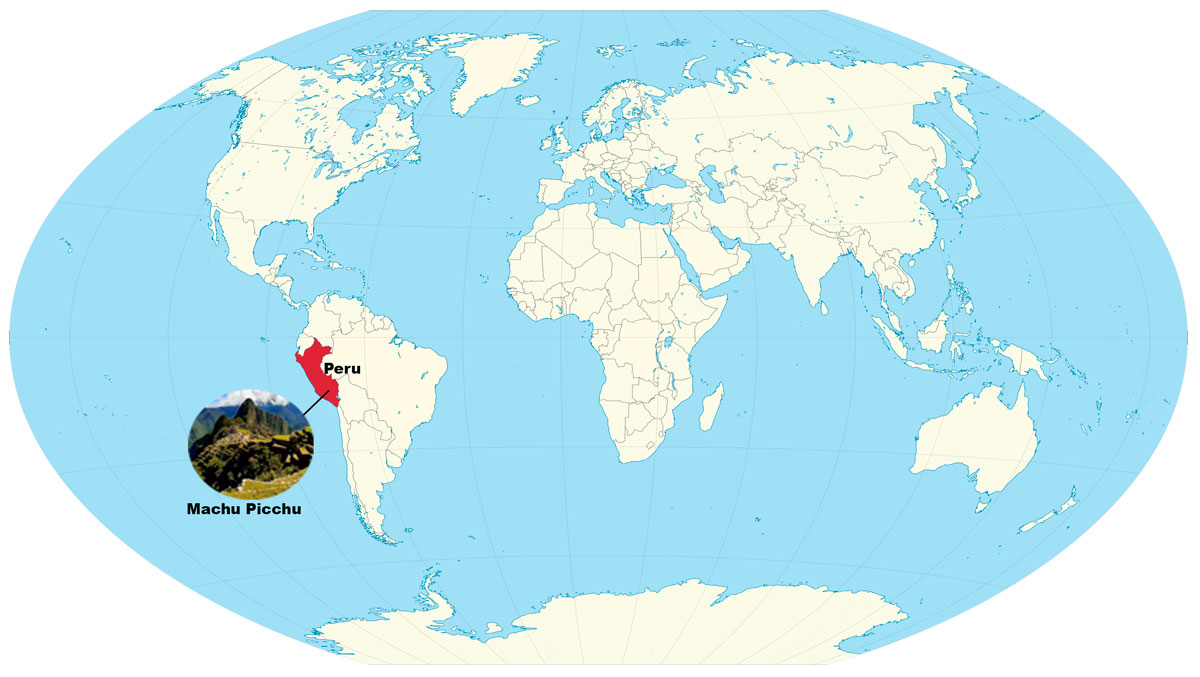 |
Where is Machu Picchu located in the world map? |
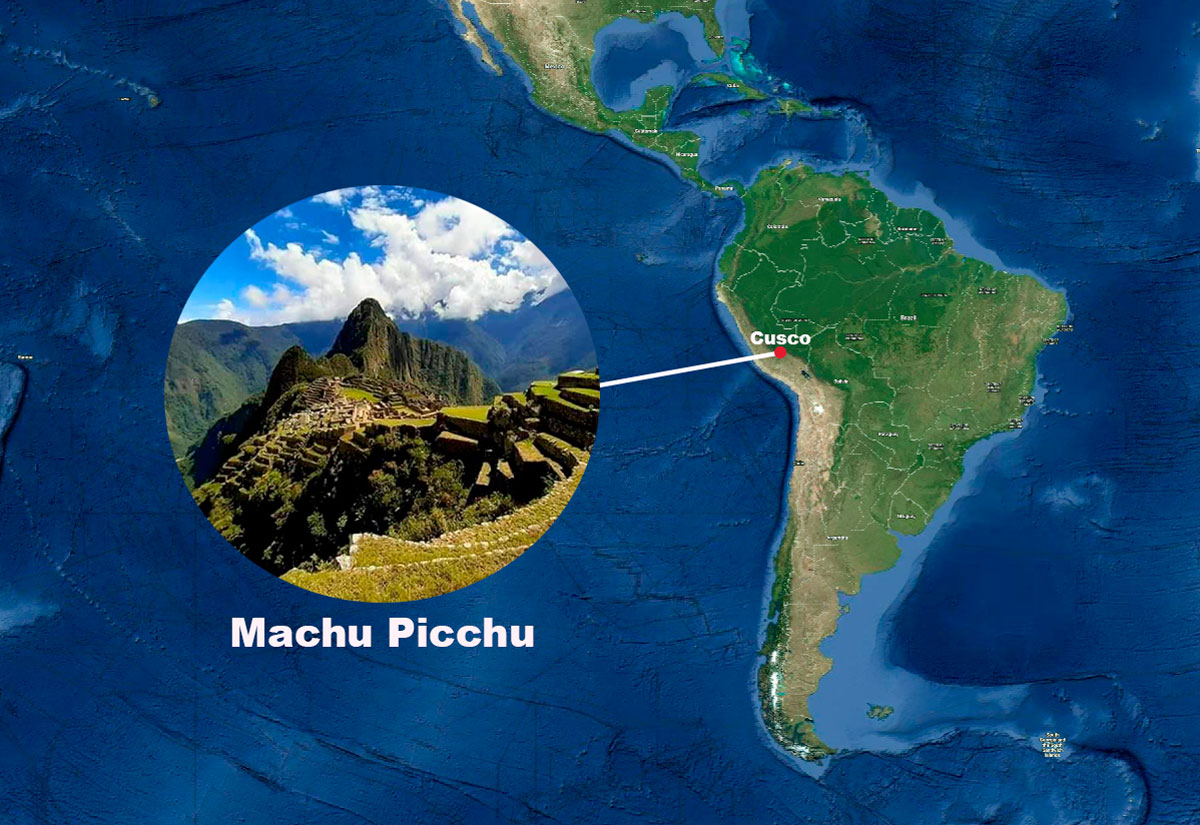 |
Where is Machu Picchu in South America Map? |
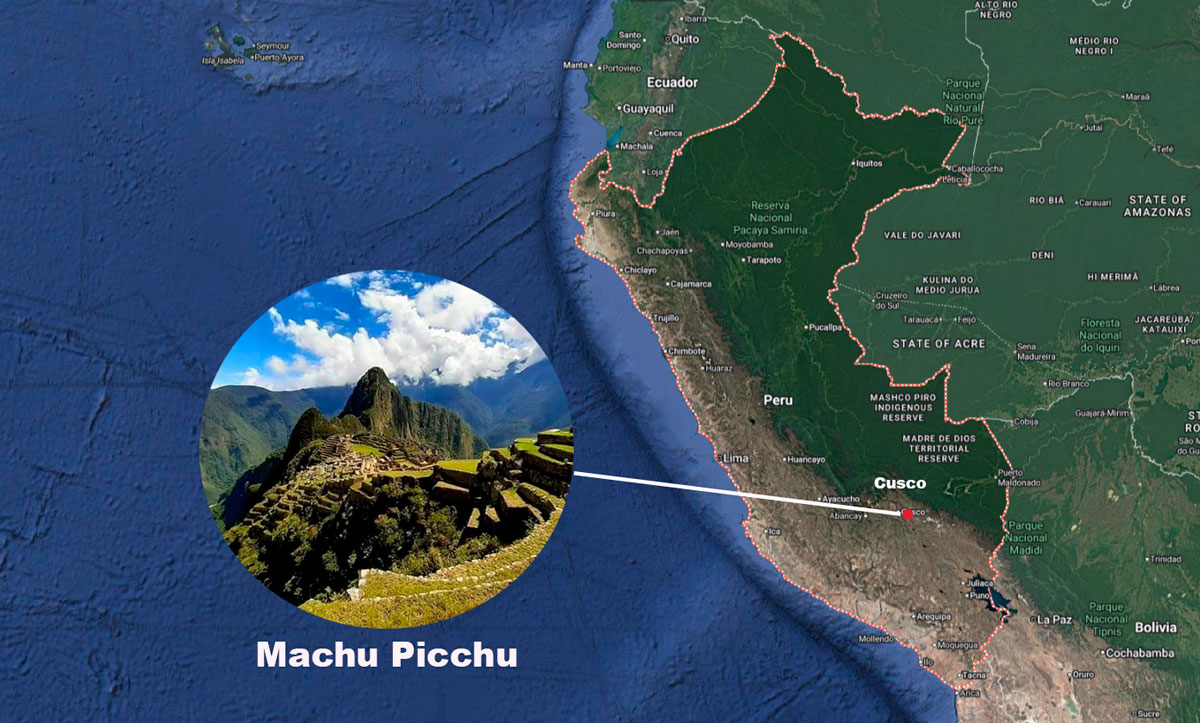 |
Where is Machu Picchu in Peru located? |
The official language in Aguas Calientes is Spanish, but many people speak English, as the town receives numerous foreign travelers who speak English. Additionally, there are a few guides who speak French, Russian, and German. However, if you want a guided tour in your preferred language, it is very important to reserve your Machu Picchu guide in advance.
The growth of Aguas Calientes began in 1995, when people from various regions of Peru, including Quillabamba, Santa Teresa, Urubamba, and Cusco, migrated to the town in search of work opportunities related to tourism. Over time, many of these migrants decided to settle in Aguas Calientes, and the population gradually grew. While some of the residents still speak Quechua, the language has become less prevalent as Spanish and other languages have become more dominant in daily life. Despite this, Quechua is still an important part of the region’s cultural heritage, and efforts to preserve it continue among certain communities.
Although it is not the highest area in the province of Urubamba, the historic sanctuary of Machu Picchu is located at about 2,450 meters above sea level (masl).
If you are in an English-speaking country, such as the United Kingdom, the United States or Canada, you will surely be more familiar with this metric in feet. Well, in this case, the height of this emblematic place is around 8,000 feet.
As for the hills that surround the town, both the Machu Picchu mountain and the Huayna Picchu mountain are at a higher altitude. In the case of the hill that gives its name to the place, its peak is located at 2,795 meters above sea level, while to the north, the Huayna Picchu mountain has a maximum altitude of 2,667 meters.
As I was saying, despite being a considerable height, it is not one of the highest places in the area. The altitude of Cusco, for example, is around 3,400 meters, that is, about 1,000 meters difference!
If you're planning to visit Machu Picchu from Lima, there are two main travel options: by plane or by bus. Here’s a step-by-step guide to help you choose the best route.
Option 1: By Plane – Fastest Way to Reach Machu Picchu from Lima
The quickest way to get to Machu Picchu from Lima is to take a flight to Cusco. The flight takes approximately 1 hour and 30 minutes.
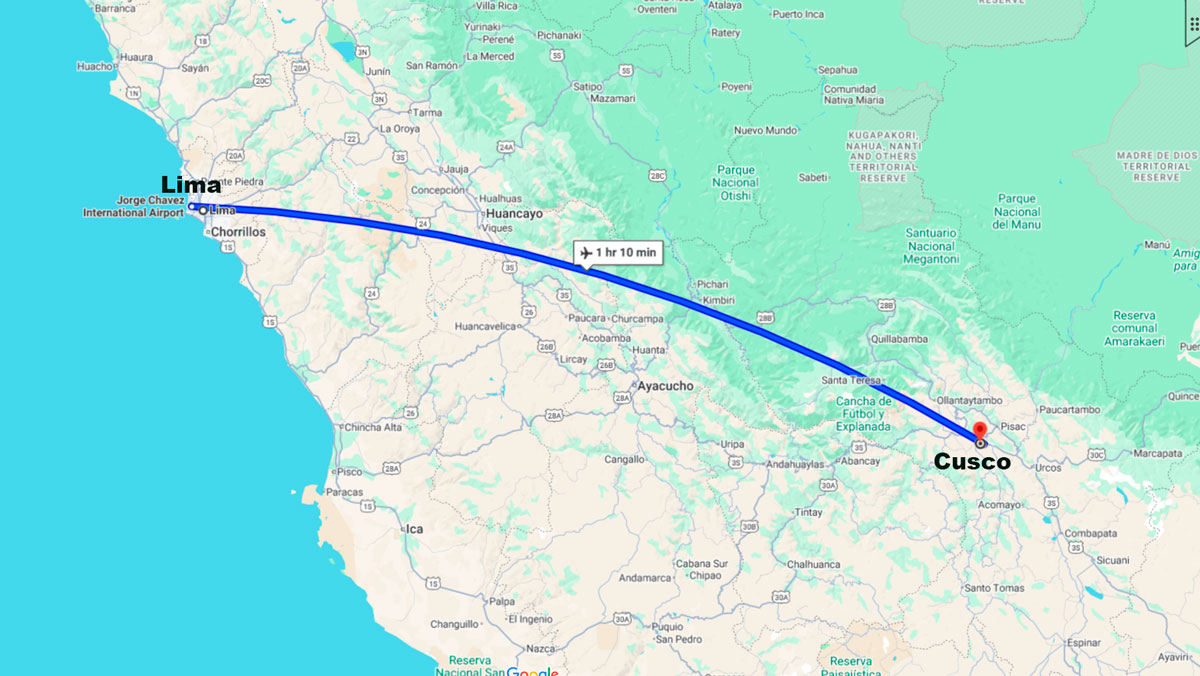 |
Where is Machu Picchu from Lima |
Once in Cusco you have two options:
Take a taxi to the historic center of Cusco (Plaza de Armas), which takes about 20 minutes.
Take a taxi or public transportation directly to Ollantaytambo, which is about 1 hour and 40 minutes by car.
From there take the train to Machu Picchu town (Aguas Calientes). The train ride takes about 1 hour and 40 minutes.
Once you arrive in Aguas Calientes, take a Consettur bus to the entrance of the Inca citadel of Machu Picchu. The bus ride takes about 30 minutes and leaves every 10 minutes.
Option 2: By Bus – Longer Route to Machu Picchu from Lima
Traveling from Lima to Cusco by bus is a long journey, taking approximately 21 to 22 hours. This option is ideal if you plan to visit other destinations along the way, such as Nazca, Paracas, Ayacucho, or other coastal and Andean cities.
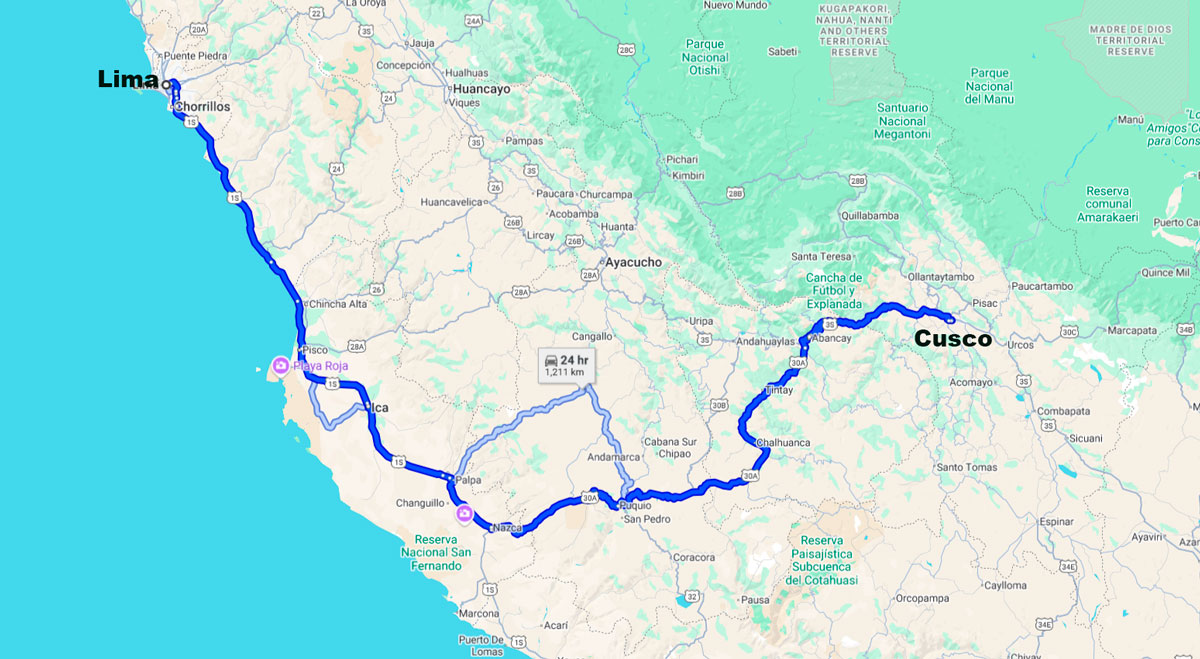 |
Where located Machu Picchu from Lima? |
Once you arrive in Cusco, follow the same steps as option 1:
Cusco → Ollantaytambo → train to Aguas Calientes → bus to Machu Picchu.
Summary: Machu Picchu from Lima
Train Stations to Reach Machu Picchu (from Cusco’s Plaza de Armas)
At PeruRail or Inca Rail, you’ll find the best train options to Machu Picchu Pueblo (Aguas Calientes), with durations between 1 hr 30 min to 3 hr 30 min, depending on the service.
Final Leg: Aguas Calientes to Machu Picchu
From Machu Picchu Pueblo, take the Consettur bus to the entrance of the Inca Citadel.
After a period of little tourism caused by the Covid 19 pandemic, Machu Picchu once again welcomed thousands of tourists as usual.
However, due to the political instability in Peru, the Inca citadel closed its doors in the first days of the year.
Even so, Machu Picchu in 2025 continues to receive visitors from various parts of the world.
The political situation in Peru caused fear in some visitors. Despite this, there are still many tourists who come to Peru to fulfill the dream of visiting Machu Picchu. All services related to Machu Picchu continue to operate normally: bus transportation, train, tour guide, restaurants, hotels and entrance to the Inca citadel.
Machu Picchu is impressive: it has temples, residences, platforms, paths and more. Most of these places are included in the tourist route in the company of a guide. To enter others it is necessary to take optional routes, as in the cases of the Intipunku and the Inca Bridge. In other cases, such as the Temple of the Moon, the visit is included in a different ticket (entrance that includes the Huayna Picchu mountain).
The Guardian's House – Famous construction from where the entire surroundings of Machu Picchu were watched since it offers a panoramic view of the place. Currently, in this place tourists take the classic postcard photo.
The Intipunku – The famous 'Sun Gate' through which the Incas entered Machu Picchu from Cusco. It was there that the sun's rays were received on the summer solstices. It consists of several walls and windows as well as a main door through which tourists currently enter on the famous 4-day hike known as the ‘Inca Trail’. Getting to the top from the current entrance to the archaeological site takes approximately 1 hour.
The Inca Bridge – The Inca Bridge is a rustic stone construction that marked the boundaries of the Inca Empire with the east. In the event of a possible threat, the Incas destroyed the bridge to prevent invasions. Currently, going there is an optional route that lasts approximately 30 minutes. It crosses sections close to cliffs but is 100% safe.
The Intihuatana – This construction is made of a large stone sculpted on three levels that directly receive the sun's rays. This sundial was used to know the planting and harvesting seasons in the place. It is believed that the inhabitants who bring their hands close to this construction are filled with the energy that comes from the sun.
The Main Temple – The Main Temple is made up of a three-walled enclosure and a main platform as an offering table. It also has large windows where ornaments were placed. Earthquakes and the passage of time have damaged these structures, which are uneven.
The Temple of the 3 Windows – The Temple of the 3 Windows, as its name indicates, is made up of a stone structure with three windows that symbolize the division of the Inca world into three levels: the Hanan Pacha (celestial world), the Kay Pacha (earthly world) and the Uku Pacha (world of the dead).
The Temple of the Condor – This temple is made up of an irregularly shaped rock as well as a stone figure on the ground; which together visually form the figure of a condor, a sacred bird for the Incas. According to the Inca worldview, the condor communicated the earthly world with the celestial world of the gods.
The Temple of the Sun – This temple was one of the main religious sites in Machu Picchu. It is made of many regularly carved stones that form a circle on top of a cave. It is on the highest point of the place so it received the sun's rays inside. Below there are some steps that lead to what would be a royal tomb, due to the relics that were found there when it was discovered.
The Temple of the Moon – This building is also known as the ‘Great Cavern’, since it is built inside a cave. It has finely carved walls and windows as well as a kind of altar where sacrifices were supposedly made. The Temple of the Moon is on the Huayna Picchu mountain, an hour from a fork in the road. Visitors who arrive at the temple will find themselves almost alone since few people go there.
During the year, Machu Picchu has two very different seasons: the dry season (from April to October) and the rainy season (from November to March). The first is characterized by the scarce presence of rain and clouds. The second, by the greater frequency of rain and cloudiness. The months with the most intense rain are January, February and March.
According to visitors who have already been to Machu Picchu, the best time to go is during the dry season (from April to October). During these months, the days are sunnier and there is less chance of rain. This makes it possible to take the best photographs of the Inca city. For many, May, June and July are the best months to visit.